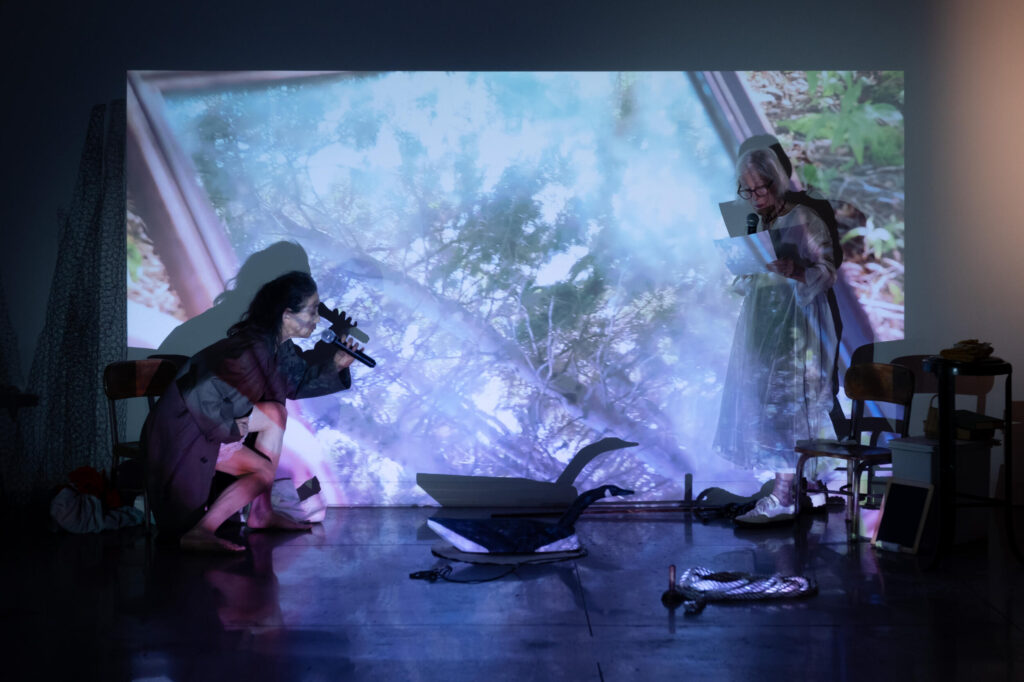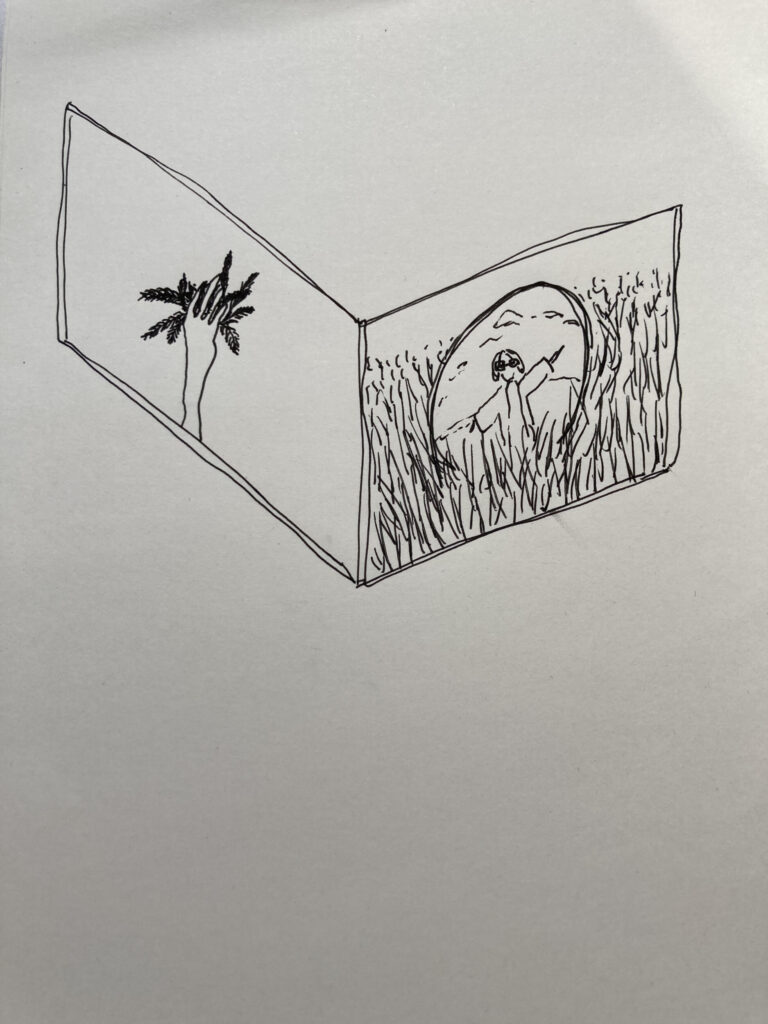Tilting the Mirror by Nora Raine Thompson
July 14, 2023

Joan Jonas & Eiko Otake, Drawing in Circles
WHY?, presented by Castelli Gallery and Danspace Project, 2023. Photo: Ian Douglas.
In this essay, Nora Raine Thompson reflects on her experience witnessing Joan Jonas and Eiko Otake's unique and historic collaborative performance and installation, Drawing in Circles WHY (an experiment), presented at the Castelli Gallery in partnership with Danspace Project. This essay is provided in text and audio. Please read or listen below.
On a Friday evening at the Castelli Gallery in midtown Manhattan, I watch two elder artists—Joan Jonas and Eiko Otake—sit stony-faced in children’s chairs. Chairs that are categorically too small for them yet also just right for their petite bodies that seem glad to squat. Versions of these signature props are spread throughout their collaboration, in physical space and on screen. There are green chairs, plastic-y ones, plucked from a modern kindergarten class. There are wooden ones, worn and battered, featuring shining chrome. Objects that contain contrast and contradiction. Like these tiny chairs, there is nothing overbearing or arrogant about Eiko and Joan’s collaboration, but rather, timelessly sturdy and resolute with a touch of whimsy. Eiko and Joan bring elements from their past into conversation and confrontation in their sprawling joint works made in the last two years: Drawing in Circles (the installation), Drawing in Circles WHY (an experiment) (the performance), and With the Earth at My Waistline (a film made at Danspace Project for Platform 2021). This eclectic collaboration seems only possible from two expert experimenters like Eiko and Joan. They are artists at play. In one vignette of With the Earth at My Waistline, the film projected in large scale on a wall of the gallery, Eiko and Joan use white chalk tied to the end of sticks to draw circles on a large swath of black paper, foretelling the title of what would be their next collaboration. They work matter-of-factly and quickly, filling up the huge sheet by plodding around each other. The video is sped up, but the two women also seem to be genuinely in a rush. They trace chalk paths through and around the circles, drawing as if solving a maze. Before I realize they are finished, they start crumpling the paper, working from the sides and using their whole bodies to crunch it smaller, shrinking their two dimensional creation into a three dimensional object, to be squeezed and shifted in wholly new ways. I am left with a sense of absence, made visceral by the particular way they erased and transformed their work. A playful way to experience loss. Drawing circles is a recurring motif in Joan’s work. In her 2002 work Lines in the Sand, for example, she carried out a similar procedure, drawing with chalk on large swaths of paper, crumpling it up, and letting the audience experience a “small shock” at the “blank space” that was created.[1] They execute such experiments like this one with a distinctive sensibility. They move curiously but without hesitation, with purpose yet without any insistence on a particular narrative. Through this focused, inquisitive work, the importance of serious playful experimentation emerges. Eiko and Joan, though each with remarkable and established styles and identities cultivated over decades, are instructive in how to keep experimenting wholeheartedly. Their brazen differences are made apparent in the set elements that make up their Drawing in Circles installation. Twin children’s chairs sit facing each other, flanked by large projections of each artist’s video contribution. A heaping pile of bundled fabric on one side of the room-that I recognize as classic to Eiko—is reflected by a smooth wooden goose on the other side, placed on the floor. An easel chalkboard with a drawing of a crescent shape, labeled “MOON,” sits on Joan’s side, too. Parallel yet not quite symmetrical, both artists are present. Eiko and Joan juxtapose and subtly mix their practices within the videos themselves. The projections evoke both their stylistic attentions, even though Joan only appears on screen in one of them, and contrast emerges as the videos play side by side. Organic rough material—weedy grass, long black feathers—meets glassy surfaces—mirrors, blank paper, clear sky. Power plays—Eiko runs full tilt towards an oncoming car and Joan slaps red paint onto paper with a cheeky glance towards the camera—are balanced with scenes of gentleness—Eiko’s hair flutters softly in the wind and Joan’s fingers graze the tips of wildflowers in bright sunlight. Contrast can be genuinely challenging, especially for two willful and brilliant artists who each could overpower a fellow performer. The good news is, neither can be overpowered. They found the right tools to bump and bounce their differences off each other as if through a prism. Glancing towards a mirror in my apartment yesterday, I expected to see myself as I usually do, walking from kitchen to living room, movements matching up with that magical-mirror-clarity. But instead of finding my image, my eyes locked with a tiny white dog. Logan, who looks a lot like Joan’s animal companion who makes a few cameos in the video works, has been staying with me the past week. I was not startled, but entranced. The mirror had been knocked a bit, tilted somehow. Reflector became portal, my body disappeared, another’s newly clear. Joan has noted that mirrors “refract reality in unexpected ways.”[2] Like the mirror made askew in my apartment, Joan and Eiko’s collaboration deftly shifts reality. Their performance, Drawing in Circles WHY (an experiment), invokes this looking glass. They dance side by side, utilizing the dual projections again, similar to the installation. Always juxtaposing, reflecting. They tell paralleling stories of fathers—Joan’s stepfather and Eiko’s father—getting tuberculosis, and recount trips to Wyoming, decades apart, with diverging experiences and impressions of the place. They sing morbid tunes they can’t forget, decades’ old earworms. Joan sings an Appalachian folk song and Eiko sings a Japanese one about child adoption in Japan. And they address their younger selves: both daring experimental artists working in New York in the 70s. Images of their naked performances of that time shine brightly, projected on the wall, the light bending over their current bodies shrouded in papery white dresses. Presented with younger Eiko and younger Joan on screen, I sense a different kind of seriousness than what they display today—the solemnity of being in your twenties and trying to prove that what you have to say is worth hearing. After the performance ends on Friday, March 24th, the artists engage in a short talk-back with Iris McCloughan, the Director of this experiment. Eiko and Joan agree that if they had met when they were younger, they would have never collaborated. Maybe this assent can be interpreted as an admission of the limits of their younger selves, the limits of cultivating (whether purposefully or not) a singular voice and style. I should admit that I've known Eiko for ten years while I've only just recently met Joan. Eiko was my teacher and I worked as her assistant for a time. I've witnessed her work shift from a powerfully slow and austere aesthetic as part of the duo Eiko & Koma, into a mischievous and daring, at times comedic, style as she engaged in roving solos and improvised duets. But there is a consistent throughline to Eiko's work: to collapse our sense of time and space, to encourage an audience’s imagination. I am still discovering Joan’s sixty-year artistic journey, but it is clear that she has, like Eiko, never stopped complicating her own practice. Moving from sculpture to mediated images to video to live performance and back again (and combining the lot on the way), she has continued to add new dimensions to her work with age. Her style, according to Karin Schneider, “necessitates play” by virtue of its “open-work structure,” keeping experimentation at the core.[3] And her effort to refract and fragment, often aided by mirrors, seems driven by her “dominant focus” on the never simple “roles that women play” in our world.[4] Today, Eiko and Joan each carry signature motifs into new experiments, with the curious confident energy that veteran artists, like themselves, seem to often possess. In this instance, they literally carry signature props forward–flowers and cloth for Eiko, chalk and mirrors for Joan, to name a few. They unite in this collaboration to transcend simple juxtaposition though, by participating in a joint ritual of conversing with their younger selves. Maybe that is why a sense of dual reverence and irreverence courses throughout this experience at the Castelli Gallery. What better way is there to talk to yourself than with respect, humility, and company? Towards the conclusion of their performance, we see black and white footage of a volcano erupting on one projection, and, on the other, a young naked Eiko crawling across a stage mottled with black curved marks. I find out later that the volcano footage was Joan’s, originally recorded in the 70s, used again in 2000 and then 2018 for reperformances of her Mirage, and now resurfaced once again for this event.[5] Layers of iteration, piling up. Both eventually face the projections head on, backs to us. Eiko stomps, Joan jangles a strangely boisterous clanging instrument. Eiko pushes black spidery feathers up against the wall as if intermixing them with the markings on the old stage, Joan waves shining rainbow ribbons tied to a stick in and out of the black and white light. They reflect on their past through a new erupting multi-layered present, a new signature form of experimentation—one that is iterative, rigorous, playful, and importantly, together. I can’t wait to see more storied legacies take this tack, trying new things with eyes wide open, remaking themselves over and over, side by side.
